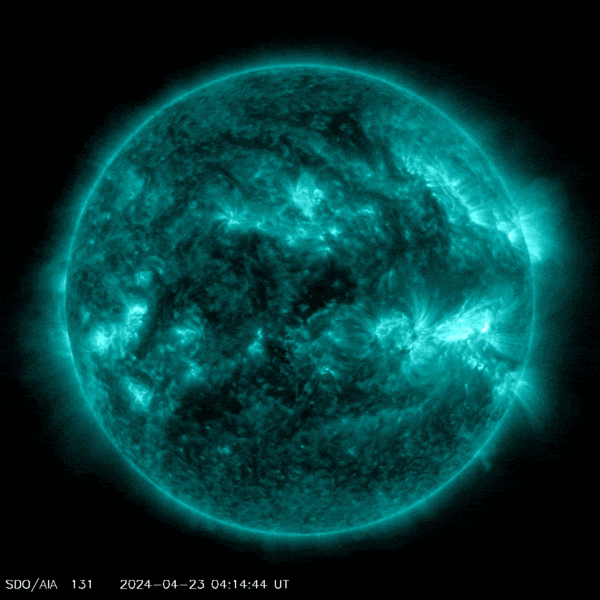Science
4 solar flares simultaneously erupt from the sun in rare 'super' explosion — and Earth could be hit by the fallout
An exceptionally rare, "quadruple" solar flare just exploded from four different points across the sun's surface at almost the exact same time. The components of this interconnected, explosive tetrad may have also launched a solar storm toward Earth — which could potentially slam into our planet in the coming days.
The four-part eruption began at around 1:00 a.m. EDT on Tuesday (April 23), according to video footage captured by NASA's Solar Dynamics Observatory. The near-simultaneous outbursts came from three sunspots and a large magnetic filament — a large loop of plasma suspended above the solar surface — located in between those three dark patches, Spaceweather.com reported. The blast sites were each separated by hundreds of thousands of miles, and the area between them covered around a third of the solar surface facing Earth.
The concurrent blasts were part of one single eruption, known as a sympathetic solar flare. This type of solar outburst happens when sunspots or filaments are invisibly linked by massive magnetic field loops that arch above the solar surface. When one detonates, the others quickly follow suit.
In almost all reported cases of such events, sympathetic flares include just two linked flares, which can range in intensity from small outbursts to X-class flares, the most powerful class of solar flares the sun can produce. However, in this case, there were twice as many flares as usual, which makes this a "super-sympathetic" flare, according to Spaceweather.com.
It is currently unclear what the combined power of the blast was. But given the large area covered by the sunspots, there is a decent chance that "at least some of the debris will be Earth-directed," Spaceweather.com reported. This debris would most likely be a massive cloud of plasma and radiation launched by one of the flares, known as a coronal mass ejection (CME). If confirmed, a CME could smash into our planet in the next few days and trigger vibrant auroras near its magnetic poles.

This is at least the third sympathetic solar flare of 2024 following a pair of explosions in January and an X-class flare duo in March.
—No, you didn't see a solar flare during the total eclipse — but you may have seen something just as special
—Solar flares created in the lab for 1st time
—Mysterious 'sparks' on the sun could help scientists predict solar flares
Sympathetic solar flares are more likely to occur during or around solar maximum, the most active phase of the sun's roughly 11-year solar cycle, according to a 2022 study that analyzed nearly 40 years of solar flare data. Some researchers believe this explosive peak may have already begun, around a year earlier than initially forecast.
-

 Science2d ago
Science2d agoInside Capitol Hill’s Latest UFO Hearings
-

 Science2d ago
Science2d agoYou Won’t Want to Miss the Leonid Meteor Shower. Here’s How and When You Can See It
-

 Science3d ago
Science3d agoHere’s What Trump’s Win Means for NASA
-

 Science6d ago
Science6d agoWhy Risky Wildfire Zones Have Been Increasing Around the World
-

 Science6d ago
Science6d agoIt’s Time to Redefine What a Megafire Is in the Climate Change Era
-

 Science1w ago
Science1w ago4 Astronauts Return to Earth After Being Delayed by Boeing’s Capsule Trouble and Hurricane Milton
-

 Science1w ago
Science1w agoThe Elegance and Awkwardness of NASA’s New Moon Suit, Designed by Axiom and Prada
-

 Science1w ago
Science1w agoSpaceX Launches Its Mega Starship Rocket. This Time, Mechanical Arms Catch It at Landing


























